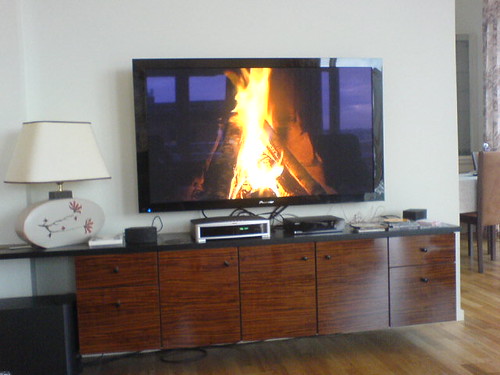 Image taken from here
Image taken from here The fireplace was originally incorporated into buildings in order to keep the indoor environment warm while the temperature outdoors dropped. But it soon came to have a secondary purpose. Being the warmest spot in the house, it became where people would gather. Thus it gained a social function – it became a place for communication and for communion. In an oral culture, the fireplace would have been where common narratives were created and propagated. It was a place of solidarity, a focal point for families and the immediate community. But as technology changed, the hearth changed too. The evolution of indoor heating in the 20th century made the fireplace obsolete in its original capacity. However, largely because of its social function [I think it’s fair to propose that its aesthetic value is linked to its social function], it remained a feature of buildings up until the end of the 20th century. Often, fireplaces were replaced by simulations of themselves such as gas fireplaces. However, the 20th century also replaced the social function of the fireplace. With the popularization of the television, families and friends were soon choosing to gather around it instead of the fireplace. The television became a new sort of electronic hearth.
As with the fireplace, common narratives were created and propagated around the television, although these narratives were being shared on a much larger scale. Also, our engagement with the narratives being spun was far more passive than before. The bodies of television viewers were inert compared to the bodies of those gathered around the fireplace.
Today, the television too is becoming obsolete, with people choosing to go to their computers (and the Internet) for entertainment and communication. For a brief period, as desktop computers, complete with large monitors and ‘towers’, became commonplace, they started to become a new sort of hearth. However, with the progressive miniaturization of technology and the ability for machines to connect to networks wirelessly, desktop computers too are fading away. The hearth, which at one point had been a stabilizing focal point of the architecture, is disintegrating. We carry our hearths around with us in our pockets.
The hearth had served a cosmological purpose, anchoring the immediate community to a place. Solidarity was focused around the hearth, with our networks radiating outward from it. The ecological metaphor of the self as an ecosystem nested within other ecosystems is complicated by the nomadicism of the cyborg at its centre. Now, for an electro-nomadic cyborg, it is as if the world were truly “an infinite sphere of which the center is everywhere and the circumference nowhere,” as Pascal once said. As with the fireplace, our new miniaturized electronic technology allows for communication and communion, and the sharing of common narratives, and it encourages a far less passive body in us than the television or the desktop computer. But in terms of providing a focal point of solidarity for the immediate community, it fails. The new technology still has an alienating component, separating us from our immediate environment while it connects us to larger networks. Architecture gives this level of environment its form, and so architects must respond to this alienation.

No comments:
Post a Comment